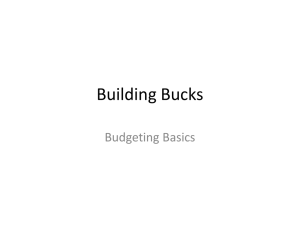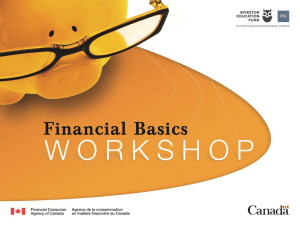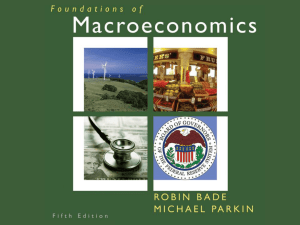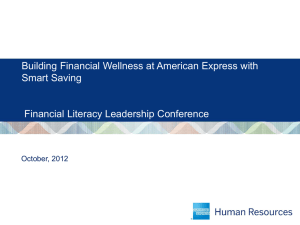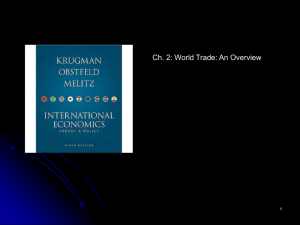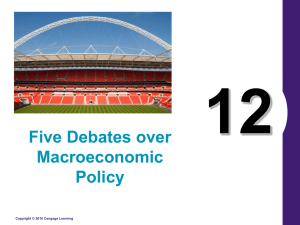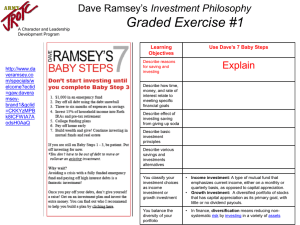Chapter 5
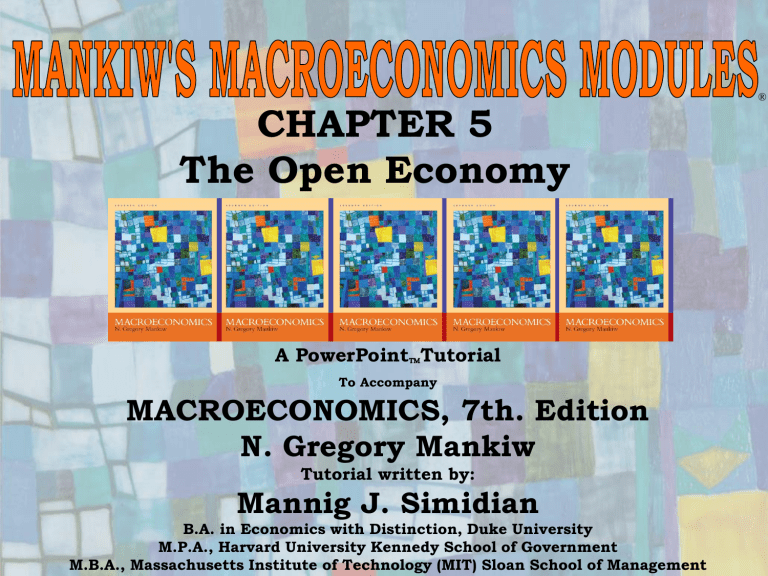
CHAPTER 5
The Open Economy
A PowerPoint
Tutorial
To Accompany
MACROECONOMICS, 7th. Edition
N. Gregory Mankiw
Tutorial written by:
Mannig J. Simidian
Chapter Five
B.A. in Economics with Distinction, Duke University
M.P.A., Harvard University Kennedy School of Government
1
M.B.A., Massachusetts Institute of Technology (MIT) Sloan School of Management
®
When an economy is so-called, “open,” it means that a country’s spending in any given year is not equal to its output of goods and services. A country can spend more that it produces by borrowing from abroad, or it can spend less and lend the difference to foreigners.
Let’s turn to national income accounting to explain.
Chapter Five 2
Y = C + I + G + NX
Total demand for domestic output is composed of
Investment spending by businesses and households
Net exports or net foreign demand
Consumption spending by households
Government purchases of goods and services
Notice we’ve added net exports, NX, defined as EX - IM.
Also, note that domestic spending on all goods and services is the sum of domestic
3 services.
Y = C + I + G + NX
After some manipulation, the national income accounts identity can be re-written as:
NX = Y - (C + I + G)
Net Exports
Output
Domestic
Spending
This equation shows that in an open economy, domestic spending need not equal the output of goods and services. If output exceeds domestic spending, we export the difference: net exports are positive. If output falls short of domestic spending, we import the difference: net exports are negative.
Chapter Five 4
Start with the national income accounts identity. Y = C + I + G + NX .
Subtract C and G from both sides and obtain Y – C - G = I + NX .
Let’s call this S , national saving .
So, now we have S = I + NX . Subtract I from both sides to obtain the new equation, S
–
I = NX .
This form of the national income accounts identity shows that an economy’s net exports must always equal the difference between its saving and its investment .
S
–
I = NX
Trade Balance
Chapter Five
Net Foreign Investment
5
Net Capital Outflow =
Trade Balance
S
–
I
=
NX
If S I and NX are positive, we have a trade surplus . We would be net lenders in world financial markets, and we are exporting more goods than we are importing. Simply put, if Saving > Investment then
Net Capital Outflow > 0 .
If S I and NX are negative, we have a trade deficit . We would be net borrowers in world financial markets, and we are importing more goods than we are exporting. Simply put, if Saving < Investment then
Net Capital Outflow < 0 .
If S I and NX are exactly zero, we have balanced trade since the value of imports equals the value of exports. Simply put, if Saving = Investment then Net Capital Outflow = 0.
6 Chapter Five
A bilateral trade balance between two countries means that the value of what a country sells to one country is equal to the value of what it buys from that country. For example, there would be a bilateral trade balance between the United States. and China if the
United States buys a pair of shoes from China valued at $300, but also sells a pair of jeans to China for $300.
A nation can have large trade deficits and surpluses with different countries but have balanced trade overall. For example, there would be balanced trade overall if the United States sells a $300 pair of jeans to
Japan, Japan sells a $300 car seat to China, and China sells a $300 pair of shoes to the United States. In this case, each country that bought something without having sold something to the country it bought the good from has a bilateral trade deficit. But, each nation has balanced trade overall, exporting and importing $300 worth of goods.
Chapter Five 7
Chapter Five
We are now going to develop a model of the international flows of capital and goods.
Then, we’ll address issues such as how the trade balance responds to changes in policy.
8
Recall that the trade balance equals the net capital outflow, which in turn equals saving minus investment. Our model focuses on saving and investment. We’ll borrow a part of the model from Chapter 3, but won’t assume that the real interest rate equilibrates saving and investment. Instead, we’ll allow the economy to run a trade deficit and borrow from other countries, or to run a trade surplus and lend to other countries.
Consider a small open economy with perfect capital mobility in which it takes the world interest rate r * as given, denoted r = r *.
Remember in a closed economy, what determines the interest rate is the equilibrium of domestic saving and investment—and in a way, the world is like a closed economy—therefore, the equilibrium of world saving and world investment determines the world interest rate.
Chapter Five 9
Y = Y = F(K, L)
C = C (Y-T)
The economy’s output Y is fixed by the factors of production and the production function.
Consumption is positively related to disposable income ( Y - T ).
I = I (r)
NX = (Y-C-G) - I or NX = S - I
Investment is negatively related to the real interest rate.
The national income accounts identity, expressed in terms of saving and investment.
Now substitute our three assumptions from Chapter 3 and the assumption that the interest rate equals the world interest rate, r *.
NX = ( Y C ( Y-T ) - G) I (r * )
NX = S - I (r * )
This equation suggests that the trade balance is determined by the difference between saving and investment at the world interest rate.
Chapter Five 10
Suppose the economy begins in a position of balanced trade. In other words, at the world interest rate, investment I equals savings S, and net exports equal zero. Let’s use our model to predict the effects of government policies at home or abroad.
Chapter Five 11
Real interest rate, r *
S In a closed economy, r adjusts to
NX equilibrate saving and investment.
In a small open economy, the interest rate is set by world r * financial markets. The difference between saving and investment r closed determines the trade balance.
In this case, since r * is r *' I(r)
NX
Investment, Saving, I , S
Above r closed and saving exceeds investment, there is a trade surplus .
Hence, starting from balanced trade, an increase in the world interest rate due to a fiscal expansion abroad leads to a trade surplus.
r * ', I would exceed S and there would be a trade deficit .
12
An increase in government purchases or a cut in taxes decreases national saving and thus shifts the national saving schedule to the left.
Real interest rate, r * r *
Chapter Five
S ' S
NX = ( Y C ( Y - T ) - G) I (r*)
NX = S - I (r*)
The result is a reduction in national saving which leads to a trade deficit, where I > S .
NX
I(r)
Investment, Saving, I , S
13
A fiscal expansion in a foreign economy large enough to influence world saving and investment raises the world interest rate from r
1
* to r
2
*.
Real interest rate, r *
S r
2
*
The higher world interest rate reduces investment in this small open economy, causing a trade surplus where S > I .
r
1
*
NX
I(r)
Investment, Saving, I , S
Chapter Five 14
An outward shift in the investment schedule from I(r)
1 to I(r)
2 increases the amount of investment at the world interest rate r*.
Real interest rate, r *
S
As a result, investment now exceeds saving I > S , which means the economy is borrowing from abroad and running a trade deficit.
r
1
*
Chapter Five
NX I(r)
1
I(r)
2
Investment, Saving, I , S
15
A Mankiw
Macroeconomics
Case Study
The U.S. Trade Deficit
During the 1980s, 1990s, and 2000s, the U.S. ran large trade deficits , with the exact size fluctuating over time yet still quite large. In 2007, the trade deficit was $708 billion or 5.1% of GDP. As accounting identities require, this trade deficit had to be financed by borrowing from abroad (i.e. selling U.S. assets abroad). During this period the U.S. went from being the world’s largest creditor to the largest debtor.
What caused the U.S. trade deficit? There is no single explanation. But to understand some of the forces at work, look at national saving and domestic investment (remember that the trade deficit is the difference between saving and investment).
The start of the trade deficit coincided with a fall in national saving. This development can be explained by the expansionary fiscal policy in the 1980s. With the support of President
Reagan, the U.S. Congress passed legislation in 1981 that substantially cut personal income taxes over the next three years. Because these tax cuts were not met with equal cuts in government spending, the federal budget went into deficit. These budget deficits were the largest ever experienced in a period of peace and prosperity, and they continued long after
Reagan left office. According to our model, such a policy would reduce national saving, causing a trade deficit. Because the government budget and the trade balance went into deficit at the same time, these shortfalls were called the TWIN DEFICITS. Lets see what happens as things start to change in the 90s on the next slide…
Chapter Five 16
A Mankiw
Macroeconomics
Case Study
More on the U.S. Trade Deficit
Things started to change in the 1990s, when the U.S. federal government got its fiscal house in order. The first President Bush and President Clinton both signed tax increases, while Congress put a lid on spending. In addition to these policy changes, rapid productivity growth in the late 1990s raising incomes and thus further increased tax revenue. These developments moved the U.S. federal budget to surplus, which in turn caused national savings to rise.
In contrast to what our model predicts, the increase in national saving did not coincide with a shrinking trade deficit, because domestic investment rose at the same time.
The likely explanation is that the boom in information technology caused an expansionary shift in the U.S. investment function . Even though fiscal policy was pushing the trade deficit toward surplus, the investment boom was an even stronger force pushing the trade balance toward deficit.
In the early 2000s, fiscal policy once again put downward pressure on national saving.
With the second President Bush, tax cuts were signed into law in 2001 and 2003, while the war on terror led to substantial increases in government spending. The federal government was again running budget deficits. National saving fell into historic lows, and the trade deficit reached historic highs.
A few years later, the trade deficit started to shrink, as the economy experienced a substantial decline in housing prices (see Chapters 11 and 18). Lower house prices reduced housing investment. They also made households poorer, inducing them to reduce consumption and increase saving. The trade deficit fell from .1% of GDP as its peak in the fourth quarter of 2005 to 4.9% in the third quarter of 2007.
The history of the U.S. trade deficit shows that this statistic, by itself, does not tell us much about what is happening in the economy. We have to look deeper at saving, investment, and the policies and events that cause them (and thus the trade balance) to change over time.
Chapter Five 17
In the next few slides, we’ll learn about the foreign exchange market, exchange rates and much more!
Chapter Five 18
Let’s think about when the United States and Japan engage in trade. Each country has different cultures, languages, and currencies, all of which could hinder trade. But, because of the foreign exchange market, trade transactions become more efficient. The foreign exchange market is a global market in which banks are connected through high-tech telecommunications systems in order to purchase currencies for their customers.
The next slide is a graphical representation of the flow of the trade between the United States and Japan, and how the mix of traded things might be different, but is always balanced. Also, notice how the foreign exchange market will play the middle-man in these transactions. For instance, the foreign exchange market converts the supply of dollars from the United States into the demand for yen, and conversely, the supply of yen into the demand for dollars.
Chapter Five 19
In order for the U.S to pay for its imports of goods and services and securities from Japan, it must supply dollars which are then converted into yen by the foreign exchange market.
Demand YEN Supply $
Foreign
Exchange
Market
Supply YEN
Demand $
In order for Japan to pay for its imports of goods and services and securities from the
U.S., it must supply yen which are then converted
Chapter Five into dollars by the foreign exchange market.
20
The exchange rate between two countries is the price at which residents of those countries trade with each other. Economists distinguish between two exchange rates: the nominal exchange rate and the real exchange rate.
The nominal exchange rate is the relative price of the currency of two countries.
The real exchange rate is the relative price of the goods of two countries.
Chapter Five 21
-relative price of the currency of two countries
-denoted as e
-relative price of the goods of two countries
-sometimes called the terms of trade
denoted as e
Chapter Five 22
The nominal exchange rate is the relative price of the currency of two countries. For example, if the exchange rate between the U.S.
dollar and the Japanese yen is 120 yen per dollar, then you can exchange a dollar for 120 yen in world markets for foreign currency.
A Japanese who wants to obtain dollars would pay 120 yen for each dollar he bought. An American who wants to obtain yen would get
120 yen for each dollar he paid. When people refer to “the exchange rate” between two countries, they usually mean the nominal exchange rate.
Chapter Five 23
Suppose that there is an increase in the demand for U.S. goods and services. How will this affect the nominal exchange rate ?
e
1 e
0 e
A
B
S $
D $
$
Dollar Value of Transactions
D $ shifts rightward and increases the nominal exchange rate, e.
This is known as appreciation of the dollar.
Events which decrease the
D $
demand for the dollar, and thus decrease e, would be a depreciation of the dollar.
Chapter Five 24
e
The real exchange rate is the relative price of the goods of two countries. That is, the real exchange rate tells us the rate at which we can trade the goods of one country for the goods of another.
To see the difference between the real and nominal exchange rates, consider a single good produced in many countries: cars. Suppose an
American car costs $10,000 and a similar Japanese car costs 2,400,000 yen. To compare the prices of the two cars, we must convert them into a common currency. If a dollar is worth 120 yen, then the American car costs 1,200,000 yen. Comparing the price of the American car
(1,200,000 yen) and the price of the Japanese car (2,400,000 yen), we conclude that the American car costs one-half of what the Japanese car costs. In other words, at current prices, we can exchange two
American cars for one Japanese car.
Chapter Five 25
We can summarize our calculation as follows:
Real Exchange Rate = (120 yen/dollar)
(10,000 dollars/American car)
(2,400,000 yen/Japanese Car)
= 0.5 Japanese Car
American Car
At these prices, and this exchange rate, we obtain one-half of a
Japanese car per American car. More generally, we can write this calculation as
Real Exchange Rate =
Nominal Exchange Rate
Price of Domestic Good
Price of Foreign Good
The rate at which we exchange foreign and domestic goods depends on the prices of the goods in the local currencies and on the rate at which
26
Real Exchange
Rate
Nominal
Exchange
Rate
Ratio of Price
Levels e
=
e
× (P/P*)
Note: P is the price level of the domestic country (measured in the domestic currency) and P * is the price level of the foreign country (measured in the foreign currency).
27 Chapter Five
Real Exchange
Rate
Nominal Exchange Ratio of Price
Rate e
=
e
× (P/P*)
Levels
The real exchange rate between two countries is computed from the nominal exchange rate and the price levels in the two countries. If the real exchange rate is high, foreign goods are relatively cheap, and domestic goods are relatively expensive. If the real exchange rate is low, foreign goods are relatively expensive, and domestic goods are relatively cheap.
Chapter Five 28
How does the level of prices effect exchange rates? It doesn’t. All changes in a nation’s price level will be fully incorporated into the nominal exchange rate. It is the law of one price applied to the international marketplace.
Purchasing-Power Parity suggests that nominal exchange rate movements primarily reflect differences in price levels of nations. It states that if international arbitrage is possible, then a dollar must have the same purchasing power in every country. Purchasing power parity does not always hold because some goods are not easily traded, and sometimes traded goods are not always perfect substitutes—but it does give us reason to expect that fluctuations in the real exchange rate will be small and temporary.
Chapter Five 29
Real exchange rate, e
Chapter Five
S-I
The law of one price applied to the international marketplace suggests that net exports are highly sensitive to small movements in the real exchange rate.
This high sensitivity is reflected here with a very flat net-exports schedule.
NX( e
)
Net Exports, NX
30
Real exchange rate, e
Chapter Five
S-I
The relationship between the real exchange rate and net exports is negative: the lower the real exchange rate, the less expensive are domestic goods relative to foreign goods, and thus the greater are our net exports.
The real exchange rate is determined by the intersection of the vertical line representing saving minus investment and downward-sloping net exports schedule.
0
NX( e
)
Net Exports, NX
Here the quantity of dollars supplied for net foreign investment equals the quantity of dollars demanded for the net exports of goods
31 and services.
Real exchange rate, e e
2 e
1
Chapter Five
S
2
I S
1
I
Expansionary fiscal policy at home, such as an increase in government purchases G or a cut in taxes, reduces national saving.
The fall in saving reduces the supply of dollars to be exchanged into foreign currency, from
S
1
I to S
2
I . This shift raises the equilibrium real exchange rate from e
1 to e
2
.
NX
2
NX
1
NX( e
)
A reduction in saving reduces
Net Exports, NX the supply of dollars, which causes the real exchange rate to rise and causes net exports to fall.
32
Real exchange rate, e e
1 e
2
S - I(r
1
*)
S - I (r
2
*) Expansionary fiscal policy abroad reduces world saving and raises the world interest rate from r
1
* to r
2
*.
The increase in the world interest rate reduces investment at home, which in turn raises the supply of dollars to be exchanged into foreign currencies.
NX
1
NX( e
)
NX
2
Net Exports, NX
As a result, the equilibrium real exchange rate falls from e 1 to e 2.
Chapter Five 33
Real exchange rate, e
S - I
2 e e
2
1
NX
2
S - I
1
An increase in investment demand raises the quantity of domestic investment from I
1 to I
2
.
As a result, the supply of dollars to be exchanged into foreign currencies falls from S - I
1 to S I
2
.
This fall in supply raises the
NX( e
) equilibrium real exchange rate from e
1 to e
2
.
NX
1
Net Exports, NX
Chapter Five 34
Chapter Five
Net exports
Net capital outflow
Trade balance
Trade surplus and trade deficit
Balanced trade
Small open economy
World interest rate
Nominal exchange rate
Real exchange rate
Purchasing-power parity
35
